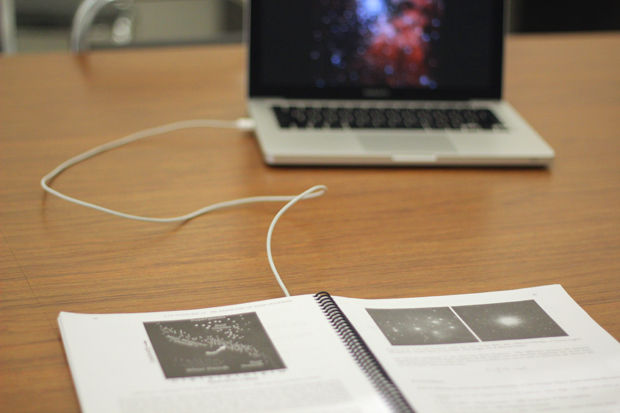Updating textbooks with technology
Washington State University Global Campus and the provost’s office are hosting the Technology Test Kitchen. Until May, faculty and staff can attend sessions to learn more about up-and-coming technology that can be applied within the classroom.
April 3, 2015
Holland 150 just received a high-tech makeover – if only temporarily.
The Test Kitchen hopes to teach faculty how to integrate technology into their classrooms in new and interesting ways. This doesn’t mean tossing print textbooks in favor of eBooks. This means using technology like Augmented Reality (AR), or virtual reality, to enhance the textbooks that professors already use.
Augmentation can mean many things, but in this case AR is used to overlay information to make learning more interactive and accessible for students. In most cases, this refers to the addition of audio, visual, GPS, or video.
“In the past, we’ve basically treated the student as something that we add the information to their brain for years and then they go off into the world and they overlay their information on the world,” said Theron DesRosier, e-learning consultant for the WSU Global Campus. “But now with these tools, these Augmented Reality tools, they can get information just in time. They can learn about something just by looking at it.”
On Tuesday, DesRosier along with Information Technology Specialist Rob Baker gave a hands-on tutorial of Google Cardboard. With the help of a Smartphone and an app, anyone can use specially designed cardboard goggles to see everything from virtual museums to WSU classrooms in a panorama view.
Swiveling of the head will change the view, as if looking around an environment in person. This can be used to explore real museums while sitting on the other side of the world, full with a tour guide narrating the experience.
WSU virtual classrooms are in the works where students can explore a classroom while being in a remote location. This would allow for more students to enroll in classes, despite the physical room being full.
Baker described the cardboard technology as a more “immersive experience” that can be used for virtually walking through the streets of St. Louis or for watching movies in a more involved way.
As for Augmented Reality, this takes on many forms. Students can look at a simple diagram of the human body through their Smartphone lens and have the figure pop to full-color life on their phone screen, complete with the different systems and parts of the body.
Students can then remove certain systems to narrow their focus, zoom in and out, and change angles. This can also be done with the human heart, a spacecraft and individual cells, along with a variety of other items.
DesRosier said print textbooks don’t need to disappear with the integration of new technology, they just need an upgrade. Instructors can add their own notes, additional photos or videos to parts of the textbooks. All students would need to do is hover over the page or photo with their phone and a whole menu of additional option would be available.
For technology off campus, students could go to a site – such as a river for taking water samples – and gain access to a custom Wikipedia page for that site. They could see notes other individuals have made and add their own.
“They can gather the information that communities have added to this thing and experience it as they need it,” DesRosier said.
While Cardboard Google and Augmented Reality offer an incredible amount of depth to existing learning tools, these are just two of the new methods WSU is looking to employ in classrooms.
The Technology Test Kitchen started with open houses on March 25 and will run until May 1, with different workshops each day. Features include virtual classrooms, 3-D printing and Google Cardboard devices, among other new technologies.
Mondays are a brown bag session, while Tuesday, Wednesday and Thursday are for presentations on specific tools, and Fridays are open labs where faculty can explore different technologies.
Reporting by Rowan Lopez Forkey















